Advancing Health Around the World
Health threats recognize no political or geographic borders. Indeed, given today’s increasingly interconnected world, diseases in any part of the world can easily reach into the U.S. population. Beyond individual illness, the social and economic consequences of global disease, especially in developing nations, often can be felt in many ways in the United States.
In this era of globalization, the United States has an important role to play in maintaining health and mitigating risk, and the Institute of Medicine (IOM) regularly examines these responsibilities from a number of perspectives. The IOM has considered how the nation can best protect its residents from global health threats and also how it can help other countries with limited resources to tackle health problems within their own borders.
Helping fight cardiovascular disease
A growing challenge worldwide is cardiovascular disease (CVD). Once considered mainly a problem in industrialized nations, CVD, especially coronary heart disease and stroke, has emerged as a major health threat in developing countries. CVD now accounts for nearly 30 percent of deaths in low- and middle-income countries each year and is accompanied by significant economic repercussions. Yet most governments, global health institutions, and development agencies have largely overlooked CVD as they have made investments in health in developing countries.
In response to this lack of attention, the National Heart, Lung, and Blood Institute (NHLBI) asked the IOM to convene a committee of experts
to assess current knowledge and strategies for meeting the challenge of CVD, offer guidance to the NHLBI in setting priorities for its investments in global CVD control, and, more broadly, identify ways in which the global health agenda can be made more inclusive of chronic diseases, including cardiovascular disease.
Once considered mainly a problem in industrialized nations, cardiovascular disease, especially coronary heart disease and stroke, has emerged as a major health threat in developing countries.
In its report, Promoting Cardiovascular Health in the Developing World: A Critical Challenge to Achieve Global Health (2010), the committee provides an up-to-date assessment of the state of CVD around the world and lays out a detailed vision for how to curb the rapid growth of CVD and related chronic diseases in low- and middle-income nations. The report emphasizes that success will depend on a wide array of stakeholders taking action at the global, regional, and local levels. The report offers specific recommendations and guidance for both short-term and long-term actions for a number of important target audiences, including governments, international health and development agencies, academic and research institutions, the private sector, and nongovernmental groups.
To ensure that these critical audiences receive the key messages of the report and are prompted to begin concrete planning for implementing the recommendations, the IOM has undertaken a 2-year communications effort with the support of several private donors. Activities include widespread distribution of the report and summary materials, presentations of the report at scientific meetings and global health events, publication of editorials and articles building on the report, and tailored briefing events in Geneva and Washington. In addition, the announcement of a United Nations (UN) high-level meeting on noncommunicable diseases held in conjunction with the UN General Assembly in September 2011 triggered a wide range of communications and advocacy events focusing on global chronic diseases by other organizations, many of which have drawn on the report as a resource.
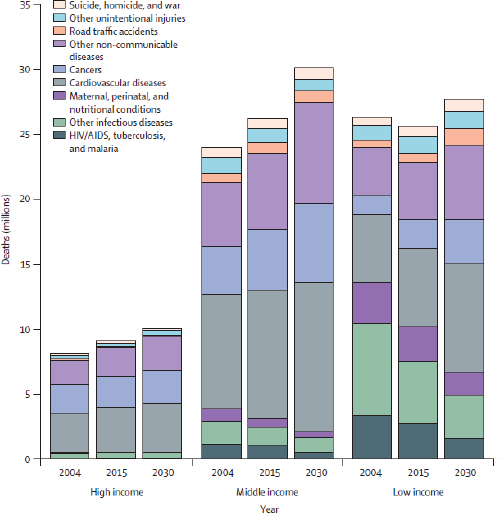
Projected global deaths by cause.
SOURCE: Promoting Cardiovascular Health in the Developing World: A Critical Challenge to Achieve Global Health, p. 50.
The report emphasizes the need to create environments that promote lifestyle choices that help protect heart health, and this requires public health infrastructure and health systems with the capacity to conduct programs that will effectively detect and reduce risk and manage CVD. It identifies the following essential functions that will be required to meet these goals:
• Exercise leadership and advocacy to tackle chronic diseases, including CVD.
• Build evidence-based and locally relevant solutions.
• Assess what works, and disseminate innovative interventions.
• Promote solutions through collaboration among key stakeholders based on clearly defined goals.
• Work toward global progress in reducing the global burden of cardiovascular disease.
Successfully carrying out these functions will require resources—financial, technical, and human—and the combined efforts of multiple players sustained over many years.
Private industry should work to reduce people’s consumption of salt, sugar, saturated fats, and trans fats—all contributors to cardiovascular disease. Policy makers in each country, working with their partners, will need to determine how best to carry out risk-reduction initiatives in light of the particular conditions, infrastructure, and resources within the country. Research organizations and government agencies should prioritize research, assessment of current CVD interventions, and information sharing among all parties. It will be important as well for all parties to help improve healthcare facilities, build the medical work force, and strengthen primary healthcare services in low- and middle-income nations, and to ensure that health service providers include prevention and care for cardiovascular disease and other chronic diseases as a focus.
Infectious diseases crossing borders
The United States and the world face threats from a number of emerging infectious diseases. Zoonotic pathogens—infectious agents transmitted from animals to humans—are now responsible for most new infectious disease events. The conditions that can promote the spread of zoonotic pathogens and diseases, such as international travel and global shipments of animals and animal products, are becoming ever more common, raising the chances that new outbreaks will emerge with devastating health, economic, environmental, agricultural, and sociopolitical consequences.
Zoonotic pathogens—infectious agents transmitted from animals to humans—are now responsible for most new infectious disease events.
In response to such concerns, the U.S. Agency for International Development (USAID) asked the IOM and the National Research Council
for advice on how to improve global capacity for surveillance and response to emerging zoonotic diseases. After detailing what is known about the transmission of zoonotic disease, exploring the current capacity for zoonotic disease surveillance, and outlining research and other needs to improve global surveillance and responses efforts, the committee appointed to this task continued to pursue many remaining questions about how best to protect humans worldwide from the transfer and spread of diseases from animals. In Sustaining Global Surveillance and Response to Emerging Zoonotic Diseases (2009), the committee offers a detailed plan for establishing and funding a comprehensive, globally coordinated system to identify novel zoonotic disease threats as early as possible wherever they arise so appropriate responses can be implemented.
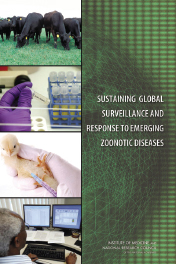
U.S. federal agencies, including USAID, should spearhead efforts to develop this system and work with international partners to provide funding and technical assistance to build the expertise, equipment, and other components of zoonotic disease surveillance and response capabilities in countries worldwide. Greater integration of the human health and veterinary medicine sectors should be a key feature of this new system, because the current lack of coordination and communication between these groups results in missed opportunities to detect potential species-crossing pathogens and leads to less effective measures to contain diseases. There also should be a fundamental shift in surveillance away from urgent, time-constrained reactions to new individual diseases and toward a sustained focus on preventing the conditions for zoonotic agents to emerge and detecting possible threats on an ongoing basis.
International travel and commerce—most notably the explosive growth of commercial air transportation over the past 50 years—drives the rapid, global distribution of microbial pathogens and the organisms that harbor them.
The IOM, through its Forum on Microbial Threats, also took a broader look at the spread of infectious diseases, largely from human activities, across national borders and around the world. Today, international travel and commerce—most notably the explosive growth of commercial air trans-

Zoonotic disease hotspots and selected reference laboratories by location.
SOURCE: Sustaining Global Surveillance and Response to Emerging Zoonotic Diseases, p. 10.
portation over the past 50 years—drives the rapid, global distribution of microbial pathogens and the organisms that harbor them. Human travel and migration have been implicated in the spread of numerous diseases, including influenza and severe acute respiratory syndrome.
In response to such concerns, the forum held a public workshop to explore a variety of topics associated with the emergence, detection, and surveillance of infectious diseases globally. The expert presentations and group discussions are presented in Infectious Disease Movement in a Borderless World: Workshop Summary (2010). Topics discussed included the historical role of human migration and mobility in the movements of pathogens and organisms that carry them; the complex interrelationship of travel, trade, tourism, and infectious disease emergence; national and international biosecurity policies related to globalized pathogens; the limitations and potential benefits of the latest round of International Health Regulations, enacted by the World Health Organization (WHO) in 2005; and obstacles
and opportunities for detecting and containing pathogens early, thereby reducing the potential burden of emerging infectious diseases.
One of the most devastating diseases ever to plague humanity was smallpox, now eradicated. Today, all known live stocks of the disease’s causative agent, variola virus, are stored in two repositories sanctioned by WHO, one in the United States and one in Russia. Since eradication, the World Health Assembly (WHA)—WHO’s decision-making body—has debated whether to retain or destroy these stocks of live variola virus.
To help prepare for this decision, the U.S. Department of Health and Human Services’s Biomedical Advanced Research and Development Authority and the Centers for Disease Control and Prevention asked the IOM to review the most recent decade of research and determine what unmet needs still exist that require the use of live variola virus. The resulting report, Live Variola Virus: Considerations for Continuing Research (2009), found that developing medical countermeasures against this deadly pathogen remains an essential need because of the potential for an accidental or deliberate release, and that having access to stocks of live variola virus will critically aid researchers in reaching these goals.
At a January 2011 meeting, WHO’s executive board supported the retention of smallpox virus stocks in the authorized repositories for research purposes, a position in line with IOM recommendations. Also, in May 2011 the WHA met to discuss retention versus destruction of the variola virus, and it strongly reaffirmed the organization’s previous decisions that the remaining stocks should be destroyed only when crucial research has been completed. At a meeting scheduled for 2014, the WHA plans to again review the state of variola virus research and discuss a date for destruction of the remaining virus stocks.
In another forum workshop focused on infectious diseases, participants examined the growing phenomenon of antimicrobial resistance (AMR). Today, some strains of bacteria and viruses are resistant to all but a single drug, and some may soon have no effective treatments left in the medicine chest. Drug-resistant pathogens have become a global challenge, aided and abetted by the use, misuse, and overuse of once highly effective antibiotics and other antimicrobial drugs. Antibiotic Resistance: Implications for Global Health and Novel Intervention Strategies: Workshop Summary (2010) captures the discussions.
Assessing federal HIV/AIDS programs
Although the United States continues to confront an HIV/AIDS epidemic that has affected millions of residents, the challenges are even greater in many other nations, including many that lack adequate resources to fight back. For years, the federal government has played a leading role in efforts to reduce the impact of HIV/AIDS in countries around the world. In a major commitment, President George W. Bush in 2003 launched the President’s Emergency Plan for AIDS Relief (PEPFAR), providing $15 billion in relief. Congress, through the Lantos-Hyde Reauthorization Act of 2008, expanded program funding to $48 billion, to treat not only AIDS but tuberculosis and malaria as well. The reauthorizing legislation also called upon the IOM to assess the performance of PEPFAR and the impact of the program’s activities on health, and to make recommendations to improve the government’s response to global HIV/AIDS.
Although the United States continues to confront an HIV/AIDS epidemic that has affected millions of residents, the challenges are even greater in many other nations, including many that lack adequate resources to fight back.
The IOM committee conducted the study in two stages. First, the committee was charged to develop a plan for the evaluation and to issue a short report to Congress. In Strategic Approach to the Evaluation of Programs Implemented Under the Tom Lantos and Henry J. Hyde U.S. Global Leadership Against HIV/AIDS, Tuberculosis, and Malaria Reauthorization Act of 2008 (2010), the committee presented an overview of the strategic approach and conceptual framework for the assessment and evaluation of PEPFAR. The proposed approach was designed to support an assessment of whether the program is performing in the way it is intended along the full range of its implementation, rather than simply an evaluation of its ultimate impact. This would allow for refined conclusions about elements of the program that are functioning well or that could be improved to result in a greater impact on health.
Within countries that receive PEPFAR support, the evaluation was to cover a range of factors that
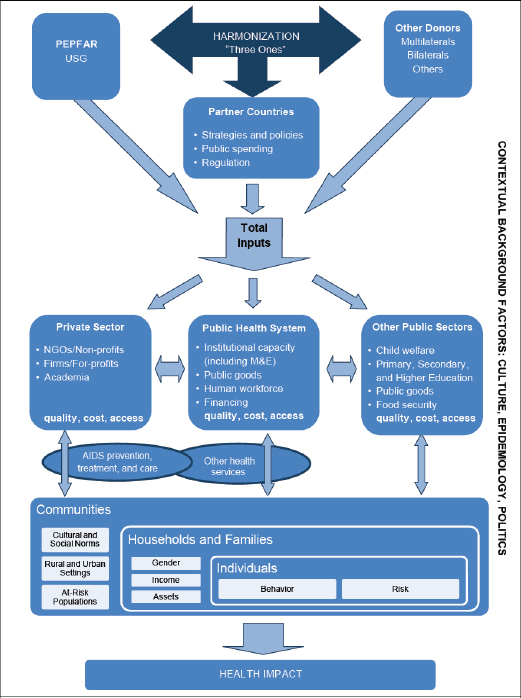
Context for PEPFAR program implementation.
NOTES: M&E = monitoring and evaluation; NGOs = non-governmental organizations; USG = U.S. government.
SOURCE: Strategic Approach to the Evaluation of Programs Implemented Under the Tom Lantos and Henry J. Hyde U.S. Global Leadership Against HIV/AIDS, Tuberculosis, and Malaria Reauthorization Act of 2008, p. 26.
can affect the implementation of the program and health outcomes, including cultural, societal, geographical, and political factors and influences, as well as the presence of investments and activities from a range of other external and country-level sources that are aimed at achieving the same health impact. Given the multiplicity of factors that influence outcomes, the goal of the analysis was to assess PEPFAR’s contribution to changes in health impact, as determining direct attribution will not be possible.
In the second phase of the study, the IOM began its evaluation of PEPFAR in the fall of 2010 and is scheduled to release a report in 2012. Based on the conclusions of the evaluation, the IOM will make recommendations that focus on improving the government’s response to global HIV/ AIDS, including support for and alignment with global and local responses at the country level. The report is intended to inform decisions about how to identify, disseminate, and scale up the most effective and efficient strategies in order to make the best use of limited resources to accomplish PEPFAR’s goals for a transition to a sustainable, country-owned response to the pandemic.
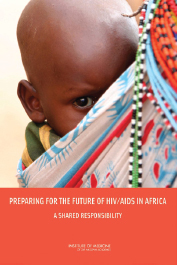
PEPFAR has provided approximately $32 billion to HIV/AIDS-related programs since it was established in 2003. The epidemic in Africa is catastrophic and further amplified because the region lacks sufficient resources to meet the need for life-saving antiretroviral therapy (ART). In Preparing for the Future of HIV/AIDS in Africa: A Shared Responsibility (2010), the IOM identifies strategies for both African nations and the United States to build African capacity—including human, scientific, technological, organizational, institutional, and/or resource capabilities—to prevent, treat, and care for HIV/AIDS. More information about this report can be found in the chapter on the healthcare workforce.
Challenges of drug-resistant tuberculosis
An estimated 2 billion people, one-third of the global population, are infected with the bacterium that causes tuberculosis (TB). Spread through the air, this infectious disease kills 1.8 million people each year. Exacerbating this devastation is the growing threat of drug-resistant strains of the disease in many parts of the world. The year 2008 saw an estimated 440,000 new cases of drug-resistant TB and 150,000 deaths from drug-resistant strains of TB. The increasing burden of drug-resistant TB introduces significant new challenges to traditional control and treatment programs.
In recognition of this emerging threat, the IOM Forum on Drug Discovery, Development, and Translation launched an initiative focused on drug-resistant TB. It began with a workshop in Washington, DC, in November 2008 and continued with a series of workshops held in countries with a very high burden of drug-resistant TB. The international workshops, taking place between 2010 and 2012, are intended to enable participants to learn from the historical and contemporary experiences of each nation’s public health community in controlling and combating the spread of drug-resistant TB, and to draw lessons about best practices and novel approaches that can be applied in the regions and across the globe. The presentations and discussions among workshop speakers and guests also are intended to help forge new linkages and collaborations across multiple disciplines and countries and facilitate the sharing of scientific knowledge to benefit TB control efforts.
An estimated 2 billion people, one-third of the global population, are infected with the bacterium that causes tuberculosis.
The first international workshop was held in South Africa, cohosted by the Academy of Science of South Africa. It brought together disease experts, community leaders, policy makers, and patient advocates from that nation; other countries in southern Africa; and the United States, and their presentations and discussions are captured in The Emerging Threat of Drug-Resistant Tuberculosis in Southern Africa: Global and Local Challenges and Solutions: Workshop Summary (2011).
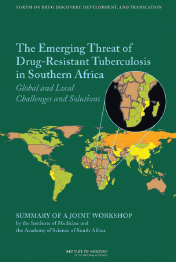
For the second international workshop, held in Russia in collaboration with the Russian Academy of Medical Sciences, participants came from that nation, the United States, South Africa, and China. Those discussions are presented in The New Profile of Drug-Resistant Tuberculosis in Russia: A Global and Local Perspective: Workshop Summary (2011). This workshop also was the first in a series of meetings of the U.S.-Russia Scientific Forum for Biomedical and Behavioral Research, which grew out of an agreement between Presidents Barack Obama and Dmitry Medvedev at their summit in July 2009, a date that also marked the 50th anniversary of collaboration between the Russian Academy of Sciences and the U.S. National Academy of Sciences.
Each of the workshops explored a number of common challenges. For example, many countries face an increasing incidence of drug-resistant TB. Also, drug-resistant TB is having an increasing—and devastating—impact among children, who pose unique challenges for prevention and treatment. There are numerous problems in monitoring and tracking the spread of drug-resistant TB, and many health systems lack the capacity, both technical and human, to deliver appropriate treatment for drug-resistant TB.
Drug-resistant tuberculosis is having an increasing—and devastating—impact among children.
There also are some common opportunities. Among them, the development and implementation of a point-of-care diagnostic test to detect drug-resistant TB would speed the effective diagnosis of patients and permit initiation of treatment as soon as possible. Such an innovation could reduce the period of a patient’s infectivity and thereby help protect others in the community.
The forum held a third workshop in India in April 2011, in collaboration with the Indian National Science Academy and the Indian Council of Medical Research, and a report is forthcoming. Continuing the effort undertaken at the meetings in South Africa and Russia, participants in this third international workshop considered the current status of drug-resistant TB in India and across the globe, highlighted key challenges to controlling the spread of drug-resistant strains, and discussed innovative strategies to advance and harmonize local and international efforts to prevent and treat drug-resistant TB.
Plans are now under way for a fourth workshop, to be held in China.
Mental health needs in sub-Saharan Africa
Disorders of the nervous system are common to all countries and cause tremendous suffering. In sub-Saharan Africa—where the majority of the world’s poorest countries with the least resources are found—the burden of mental health, neurological, and substance use disorders is especially significant. Epilepsy, depression, and drug and alcohol abuse affect the lives of millions of people, disrupting the daily course of life, challenging families, and weighing on the social and economic fabric of the region.
The IOM Forum on Neuroscience and Neurological Disorders, in conjunction with the Uganda National Academy of Sciences Forum on
Health and Nutrition, hosted a workshop in Kampala, Uganda, to discuss the current state of care for mental, neurological, and substance use disorders in the region. More than 150 researchers, providers, patient advocates, and policy specialists participated, and their presentations and discussions are presented in Mental, Neurological, and Substance Use Disorders in Sub-Saharan Africa: Reducing the Treatment Gap, Improving Quality of Care: Workshop Summary (2010).

The WHO’s optimum mix of mental health services.
SOURCE: Mental, Neurological, and Substance Use Disorders in Sub-Saharan Africa: Reducing the Treatment Gap, Improving Quality of Care: Workshop Summary, p. 33.
Among the goals set for the workshop was to identify strategies to improve the quality and consistency of care delivered in sub-Saharan Africa, taking into account resource constraints, infrastructure limitations, and other realities. Toward this aim, participants examined opportunities to ensure continuity of care and provide sustainable care within a country’s existing healthcare system; identified resources that are either currently available or could be made available in cost-effective and efficient ways to aid in the treatment and prevention of disease; assessed the need for national, evidence-based policies within national healthcare systems that consider the quality of care for mental, neurological, and substance use disorders; and explored ways to facilitate collaborations among a variety of stakeholders, including policy makers and healthcare professionals.
Beyond disease: The global burden of violence
The WHO estimates that more than 1.6 million people worldwide die each year as a result of violence, and millions more are injured physically or emotionally. But such violence is not unavoidable, and it can be stemmed. In 2010, the IOM launched the Forum on Global Violence Prevention to work to reduce violence worldwide by promoting research and encouraging evidence-based prevention efforts. Additional information about the IOM’s newest forum can be found in the chapter on IOM’s convening activities.
In 2010, the Institute of Medicine launched the Forum on Global Violence Prevention to work to reduce violence worldwide by promoting research and encouraging evidence-based prevention efforts.














